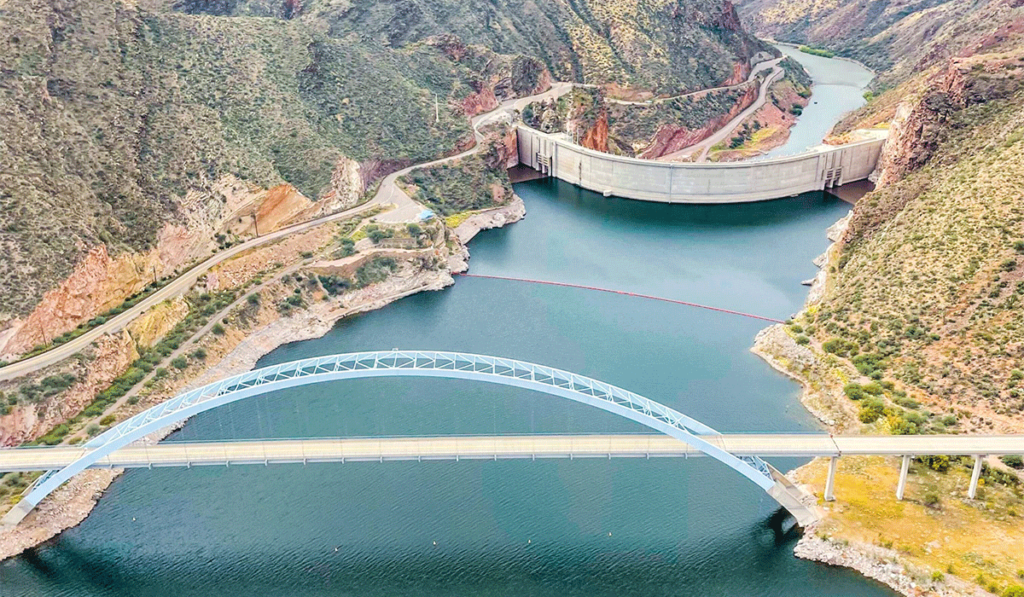
Aerial image of the Roosevelt Dam at Roosevelt Lake taken in November 2021. Photo by Lindsay Hahn, courtesy of Greater Phoenix Economic Council.
Water, one of the most important elements in the semiconductor manufacturing process, has always been a precious resource in Arizona. Its conservation and management have been a priority for generations, even predating statehood. More than any other state, Arizona understands the importance of long-term planning — it was the first to project its water supply 100 years into the future and remains one of the only states in the nation to do so. This proactive approach to water management ensures that any new developments have access to water for generations to come.
This commitment to transparency and resiliency in water management is vital for semiconductor manufacturers. Companies like Intel and Taiwan Semiconductor Manufacturing Company chose to grow in Greater Phoenix because it provides a strategic location, stable energy grid and skilled workforce, but these location decisions also rely on the availability and reliability of water. Arizona’s commitment to resilient water management and transparency in long-term planning gives companies confidence in the region’s future.
Part of this commitment includes constant reporting, adjustment and augmentation of water resources across the state. A recent analysis indicated that groundwater demands in the market could exceed groundwater supplies by 4% over the next century. This alert has enabled the market to initiate a timely response that will address any potential water concerns. The City of Phoenix has already begun design on a cutting-edge water recycling facility that will produce nearly 70,000 acre-feet of water annually by 2030, surpassing the projected 4% groundwater shortfall.
Furthermore, proposals to increase surface water storage on the Verde River are expected to yield up to 115,000 acre-feet annually of renewable water supplies. These efforts, along with substantial investments in water conservation, augmentation and reuse measures, demonstrate Arizona’s commitment to securing its water future. Arizona has invested more than $1.2 billion in water-related initiatives, and an additional $1 billion of federal investment is being used to restore Colorado River reservoirs as part of a historic agreement between Arizona, California and Nevada.
Collaboration and partnerships have played a crucial role in Arizona’s water management efforts. The Arizona Department of Water Resources, Central Arizona Project and various water utilities work together to develop and implement sustainable water policies, which address the future needs of residents and industry alike. The Colorado River Drought Contingency Plan exemplifies this commitment, working with neighboring states to ensure the long-term viability of this vital water source.
Collaboration extends into the private sector as well. Intel first returned and restored more than 100% of its Arizona freshwater use in 2021 through water management practices, reaching its net positive water use goal nine years early. The company recently earned Platinum certification from the Alliance for Water Stewardship for water practices at the Ocotillo campus in Chandler, Arizona, which treats up to 9.1 million gallons of water per day in a 12-acre on-site reclamation facility. TSMC, the leading semiconductor manufacturer globally, made the decision to invest $40 billion in its Arizona operations, representing one of the largest foreign direct investments in U.S. history. TSMC plans to build an industrial water reclamation plant, aiming for “near-zero liquid discharge,” effectively reusing nearly every drop of water.
Water conservation and efficiency have been central to Arizona’s success. In 2022, the state was ranked third in the nation for water conservation, efficiency and sustainability policies. Despite adding 6 million people and multiplying economic output 17 times since the 1950s, water use statewide remains roughly the same. More than 89% of water entering the Greater Phoenix waste stream is reclaimed and treated for potable use.
To ensure a sustainable water future, Arizona has also prioritized water research and technology development. Its universities and research institutions are actively engaged in studying water scarcity, water quality and water treatment technologies. This commitment to research and innovation has led to the development of advanced water purification methods, such as desalination and advanced filtration techniques, which can help expand water supply options.
The future of water in Greater Phoenix is promising. Through proactive and innovative water management strategies, the region is securing a sustainable water supply. Our investments in water conservation, recycling and research are paying off, ensuring Arizona can meet the water needs of its growing population and industries, including the booming semiconductor hub. With a commitment to long-term planning, transparency and collaboration, Greater Phoenix will continue to thrive while responsibly managing its water resources for generations to come.
 Chris Camacho serves as president and CEO of the Greater Phoenix Economic Council, one of the longest-standing public-private partnerships for economic development across the country. As chief executive, Camacho leads the development and execution of the region’s strategic economic strategy, oversees domestic and international business development, and ensures the market position remains competitive through coordination with partner organizations, private-sector leaders, and municipal and state leadership.
Chris Camacho serves as president and CEO of the Greater Phoenix Economic Council, one of the longest-standing public-private partnerships for economic development across the country. As chief executive, Camacho leads the development and execution of the region’s strategic economic strategy, oversees domestic and international business development, and ensures the market position remains competitive through coordination with partner organizations, private-sector leaders, and municipal and state leadership.
In October 2021, Camacho led GPEC to being recognized as the top economic development organization globally by the International Economic Development Council a year after being named the top EDO in the U.S. in 2020.
Did You Know: Intel returned and restored more than 100% of its Arizona freshwater use in 2022 through water management practices and project investments, reaching its net positive water use goal eight years early.













Speak Your Mind
You must be logged in to post a comment.